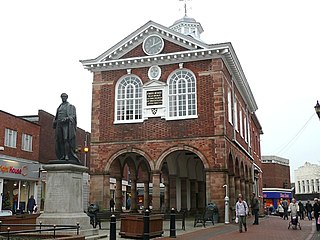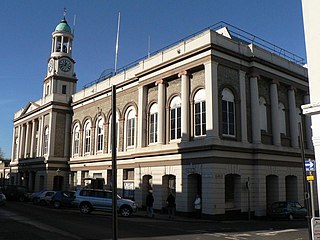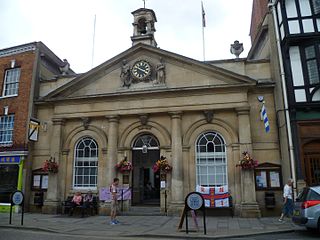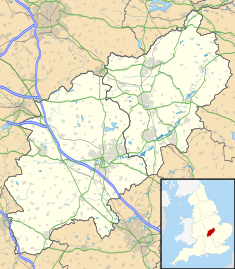
Daventry is a market town and civil parish in the West Northamptonshire unitary authority in Northamptonshire, England, close to the border with Warwickshire. At the 2021 Census Daventry had a population of 28,123, making it the sixth largest town in Northamptonshire.

Creaton is a village and civil parish in West Northamptonshire, England.

Florona Grange No. 540 Hall is a historic Grange hall and former church on Monkton Road in Monkton, Vermont. Built in 1811 as the Monkton Borough Baptist Church, it is the second-oldest church in Addison County. it is a fine example of Federal architecture with later Greek Revival additions. Its initial design is based closely on designs published by Asher Benjamin. The building was added to the National Register of Historic Places in 1989.

Southport Town Hall is on the east side of Lord Street, Southport, Sefton, Merseyside, England. It was built in 1852–53 in Palladian style, and extended to the rear on three occasions later in the century. The town hall has a symmetrical stuccoed façade with a central staircase leading up to a porch flanked by columns. At the top of the building is a pediment with a carved tympanum. The town hall is recorded in the National Heritage List for England as a designated Grade II listed building.

Ince Blundell Hall is a former country house near the village of Ince Blundell, in the Metropolitan Borough of Sefton, Merseyside, England. It was built between 1720 and 1750 for Robert Blundell, the lord of the manor, and was designed by Henry Sephton, a local mason-architect. Robert's son, Henry, was a collector of paintings and antiquities, and he built impressive structures in the grounds of the hall in which to house them. In the 19th century the estate passed to the Weld family. Thomas Weld Blundell modernised and expanded the house, and built an adjoining chapel. In the 1960s the house and estate were sold again, and have since been run as a nursing home by the Canonesses of St. Augustine of the Mercy of Jesus.

Corn exchanges are distinct buildings which were originally created as a venue for corn merchants to meet and arrange pricing with farmers for the sale of wheat, barley, and other corn crops. The word "corn" in British English denotes all cereal grains, such as wheat and barley. With the repeal of the Corn Laws in 1846, a large number of corn exchanges were built in England, particularly in the corn-growing areas of Eastern England.

Wandsworth Town Hall is a municipal building on the corner of Wandsworth High Street and Fairfield Street in Wandsworth, London. The building, which is the headquarters of Wandsworth London Borough Council, is a Grade II listed building.

Colchester Town Hall is a municipal building in the High Street in Colchester, Essex, England. The town hall, which is the headquarters of Colchester Borough Council, is a Grade I listed building.

Towcester Town Hall is a municipal building in Watling Street, Towcester, Northamptonshire, England. The town hall, which is the meeting place of Towcester Town Council, is a grade II listed building.

Tamworth Town Hall is a municipal building in Market Street, Tamworth, Staffordshire, England. The town hall, which was the meeting place of Tamworth Borough Council is a Grade II* listed building.

Llanelli Town Hall is a municipal building in Church Street, Llanelli, Carmarthenshire, South Wales. The town hall, which was the headquarters of Llanelli Borough Council, is a Grade II listed building.

Radcliffe Town Hall is a municipal structure in Spring Lane in Radcliffe, Greater Manchester, England. The town hall, which was the headquarters of Radcliffe Borough Council, is a locally listed building.

Ryde Town Hall is a municipal structure in Lind Street in Ryde, Isle of Wight, England. The town hall, which was the headquarters of Ryde Borough Council, is a Grade II listed building.

Tewkesbury Town Hall is a municipal building in the High Street in Tewkesbury, Gloucestershire, England. The building, which is the meeting place of Tewkesbury Town Council, is a Grade II* listed building.

Tiverton Town Hall is a municipal building in St Andrew Street in Tiverton, Devon, England. The structure, which was the meeting place of Tiverton Borough Council, is a Grade II listed building.

Helston Guildhall, also known as Helston Town Hall, is a municipal building in Church Street, Helston, Cornwall, England. The structure, which is the meeting place of Helston Town Council, is a Grade II* listed building.

Chipping Norton Town Hall is a municipal building in the Market Place, Chipping Norton, Oxfordshire, England. The building, which is used as an events venue, is a Grade II* listed building.

The Buttercross, also known as Brigg Town Hall, is a municipal building in the Market Place in Brigg, Lincolnshire, England. The structure, which is used as a tourist information centre and as an events venue, is a Grade II listed building.

Bewdley Guildhall is a municipal building in Load Street in Bewdley, Worcestershire, England. The structure, which is the meeting place of Bewdley Town Council, is a Grade II* listed building.

The Old Town Hall is a municipal building in East Street in the Middlehaven area of Middlesbrough, North Yorkshire, England. The structure, which has been vacant since 1996, is a Grade II listed building. The adjacent clock tower is separately listed.





















